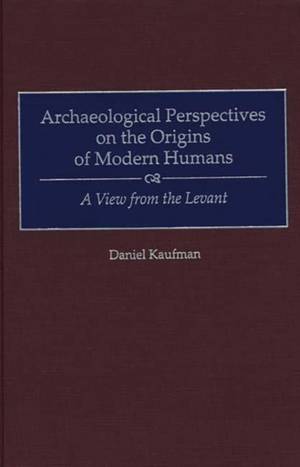
Je cadeautjes zeker op tijd in huis hebben voor de feestdagen? Kom langs in onze winkels en vind het perfecte geschenk!
- Afhalen na 1 uur in een winkel met voorraad
- Gratis thuislevering in België vanaf € 30
- Ruim aanbod met 7 miljoen producten
Je cadeautjes zeker op tijd in huis hebben voor de feestdagen? Kom langs in onze winkels en vind het perfecte geschenk!
- Afhalen na 1 uur in een winkel met voorraad
- Gratis thuislevering in België vanaf € 30
- Ruim aanbod met 7 miljoen producten
Zoeken
Archaeological Perspectives on the Origins of Modern Humans
A View from the Levant
Daniel Kaufman
Hardcover | Engels
€ 161,45
+ 322 punten
Omschrijving
Most of the literature dealing with the origins of modern humans concentrates on the European sequence, where the Levant is referred to in passing as being problematic because it does not fit with the sequence of events documented in Europe. This is the first book that attempts to examine the issues specifically from the Levant, viewing it as central rather than peripheral to the problem. It also discusses in some depth the ramifications of possible interactions between the different hominids in the region.
Rather than viewing the transition from the Middle to Upper Paleolithic as the time at which fully modern adaptive systems came to the forefront, emphasis is placed on the Middle Paleolithic itself in order to test hypotheses that hominids of this period were culturally archaic. Through an analysis of the archaeological evidence, it is concluded that by at least 100,000 years ago people of the period, usually regarded as being somewhat less than human were, on the contrary, fully modern in terms of their behavioral and cultural systems. This conclusion applies to both the Neanderthals and their anatomically modern contemporaries. The author further concludes that the cultural and behavioral differences between the two types were minimal and that there was a potential for interaction and acculturation between them. The possibility is raised that the Near East is the region in which modern human cultural adaptation arose and then dispersed to other regions.Specificaties
Betrokkenen
- Auteur(s):
- Uitgeverij:
Inhoud
- Aantal bladzijden:
- 152
- Taal:
- Engels
Eigenschappen
- Productcode (EAN):
- 9780897895781
- Verschijningsdatum:
- 30/04/1999
- Uitvoering:
- Hardcover
- Formaat:
- Genaaid
- Afmetingen:
- 156 mm x 234 mm
- Gewicht:
- 394 g

Alleen bij Standaard Boekhandel
+ 322 punten op je klantenkaart van Standaard Boekhandel
Beoordelingen
We publiceren alleen reviews die voldoen aan de voorwaarden voor reviews. Bekijk onze voorwaarden voor reviews.









